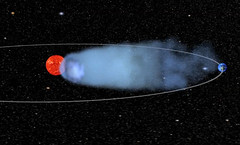Contents

WASHINGTON – Clouds of gas orbiting a black hole millions of light-years away have shapes and sizes similar to the tails of comets found in our own solar system, according to data from the Japan-U.S. Suzaku satellite. The evidence comes from the way the clouds dim X-rays emanating from hot gas near a giant black hole.
"We see a similar effect whenever a passing cloud dims the sun's light," said Roberto Maiolino at the National Institute for Astrophysics in Rome, the study's lead author. Detailed measurements of the sun's brightness would allow scientists to work out the shape and structure of the obscuring cloud. "That's essentially what we're doing, only with X-rays from a black hole in another galaxy," he added.
Using Suzaku, the researchers monitored a supersized black hole at the center of a spiral galaxy named NGC 1365. The galaxy is located about 60 million light-years away in the constellation Fornax.
The black hole contains about 2 million times the sun's mass. Gas orbiting the black hole gradually falls toward it and heats up as it gets closer. By the time the gas nears the black hole's event horizon – the point of no return - it has been heated to millions of degrees and emits vast amounts of X-rays. This intense radiation comes from a region so small that it would easily fit within the distance separating Earth and the sun – far too small to be resolved through a telescope at the galaxy's distance.
Between Jan. 21 and 25, 2007, Suzaku maintained a steady watch on the galaxy, recording X-rays with energies between 2,000 and 5,000 electron volts. That's thousands of times greater than the energy of visible light.


On two occasions, Suzaku recorded that the X-ray emission dimmed in a peculiar way. It abruptly faded during the first 15 minutes and then dimmed more slowly over several hours. The researchers think that the sudden decline was caused by a dense sharp-edged gas cloud that quickly obscured Suzaku's view.
"To account for the fast fade-out, the edge of the cloud that first covers the X-ray source must be sharp and dense," Maiolino said. "For the slower dimming, we think Suzaku's observations are showing the effect of an expanding gas trail, much like the tail of a comet."
Maiolino and his colleagues estimate that the clouds are tearing around the black hole at speeds exceeding 2 million mph. Racing through a haze of hotter, thinner gas in their environment, the clouds slowly erode, and the lost gas creates the dissolving tail. In fact, the comet-shaped clouds erode so swiftly that they may be completely destroyed within a few months.
The team estimates that the tails of the clouds Suzaku detected extend at least 125 million miles – long enough to stretch from the sun to beyond Earth's orbit. For comparison, the tails of comets in our solar system, which are produced by gas evaporating from small icy bodies, can reach even greater lengths.
The astronomers also found that the comet clouds probably lie about 12 billion miles from the black hole, a distance equivalent to about three times Pluto's distance from the sun.
"This study and others like it take us to the very brink of a monster black hole – an incredible environment we can observe in no other way," Maiolino noted.
Suzaku ("red bird of the south") was launched on July 10, 2005, as Astro-E2 and was renamed once in orbit. The observatory was developed at the Japanese Institute of Space and Astronautical Science (ISAS), which is part of the Japan Aerospace Exploration Agency (JAXA), in collaboration with NASA and other Japanese and U.S. institutions.
For more information about the mission, please visit: http://www.nasa.gov/astro-e2
Launched in 2005, Suzaku is the fifth in a series of Japanese satellites devoted to studying celestial X-ray sources. Managed by the Japanese Aerospace Exploration Agency (JAXA), this mission is a collaborative effort between Japanese universities and institutions and NASA's Goddard Space Flight Center (GSFC).
Suzaku is a satellite carrying telescopes for observing X-rays emitted by objects in the universe such as stars, galaxies and black holes. The name "Suzaku" means "vermilion bird of the south," originally from Chinese mythology. The satellite is a joint Japanese-U.S. collaboration, and was launched into orbit on July 10, 2005. Suzaku carries the X-ray Imaging Spectrometer (XIS) and the Hard X-ray Detector (HXD).
The Institute of Space and Astronautical Sciences (ISAS) in Japan, which is now part of JAXA, provided the rocket to launch Suzaku. In addition, scientists at ISAS built the HXD. Scientists and engineers at GSFC played key roles in building the X-ray Spectrometer (XRS, which suffered a catastrophic loss of coolant shortly after launch) and X-ray Telescopes (XRT). In addition, scientists at the Massachusetts Institute of Technology (MIT) contributed to the XIS instrument.
The science goals of the Suzaku mission are to help answer the following questions:
Suzaku website: http://www.nasa.gov/astro-e2
| GSFC | Goddard Space Flight Center |
| HXD | Hard X-ray Detector |
| ISAS | Institute of Space and Astronautical Sciences |
| JAXA | Japanese Aerospace Exploration Agency |
| NASA | National Aeronautics and Space Administration |
| XIS | X-ray Imaging Spectrometer |
| XRS | X-ray Spectrometer |
| XRT | X-ray Telescopes |